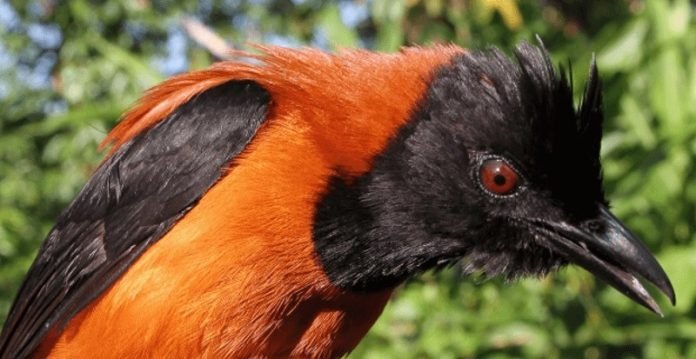
Research in the jungle of New Guinea reveals two species of birds that carry a powerful neurotoxin.
“These birds contain a neurotoxin that they can both tolerate and store in their feathers,” says Knud Jønsson of the Natural History Museum of Denmark, who worked with Kasun Bodawatta of the University of Copenhagan.
The bird species have each developed the ability to consume toxic food and turn that into a poison of their own.
The species in question are the regent whistler (Pachycephala schlegelii), a species that belongs to a family of birds with a wide distribution and easily recognizable song well known across the Indo-Pacific region, and the rufous-naped bellbird (Aleadryas rufinucha).
“We were really surprised to find these birds to be poisonous as no new poisonous bird species has been discovered in over two decades. Particularly, because these two bird species are so common in this part of the world,” says Jønsson.
The findings appear in the journal Molecular Ecology.
Poison frogs and poison birds
Most people are familiar with South and Central America’s iconic poison dart frogs—especially the golden poison frog. These small, brightly colored amphibians can kill a human at the slightest touch. The discovery of the same type of toxin in birds’ skin and feathers demonstrates that the frog toxin is more widespread than once believed.
The poison is called Batrachotoxin. It’s an incredibly potent neurotoxin that, in higher concentrations leads to muscle cramps and cardiac arrest nearly immediately after contact.
“The bird’s toxin is the same type as that found in frogs, which is a neurotoxin that, by forcing sodium channels in skeletal muscle tissue to remain open, can cause violent convulsions and ultimately death,” explains Bodawatta.
South America’s poison dart frogs use their toxin to protect them from predators. Though the level of toxicity of the New Guinean birds is less lethal, it may still serve a defensive purpose, but the adaptive significance for the birds is yet uncertain.
“Knud thought I was sad and having a rough time on the trip when they found me with a runny nose and tears in my eyes. In fact, I was just sitting there taking feather samples from a Pitohui, one of the most poisonous birds on the planet.
Removing birds from the net isn’t bad, but when samples need to be taken in a confined environment, you can feel something in your eyes and nose. It’s a bit like cutting onions—but with a nerve agent, I guess,” laughs Bodawatta.
“The locals aren’t fond of spicy food and steer clear of these birds, because, according to them, their meat burns in the mouth like chili. In fact, that’s how researchers first became aware of them. And the toxin can be felt when holding onto one of them.
It feels kind of unpleasant and hanging on to one for long isn’t an appealing option. This could indicate that the poison serves them as a deterrence of those who would want to eat them to some degree,” explains Jønsson.
How do birds live with the poison?
There is a distinction in biology between the two ways that animals deploy poisons. There are poisonous animals that produce toxins in their bodies and others that absorb toxins from their surroundings. Like the frogs, the birds belong to the latter category.
Both are believed to acquire toxins from what they eat. Beetles containing the toxin have been found in the stomachs of some of the birds. But the source of the toxin itself has yet to be determined.
What makes it possible for these birds to have a toxin in their bodies without themselves being harmed? The researchers studied this with inspiration from poison dart frogs, whose genetic mutations prevent the toxin from keeping their sodium channels open, and thereby preventing cramps.
“So, it was natural to investigate whether the birds had mutations in the same genes. Interestingly enough, the answer is yes and no. The birds have mutations in the area that regulates sodium channels, which we expect gives them this ability to tolerate the toxin, but not in the exact same places as the frogs,” says Bodawatta.
He adds: “Finding these mutations that can reduce the binding affinity of Batrathotoxin in poisonous birds in similar places as in poison dart frogs, is quite cool. And it showed that in order to adapt to this Batrachotoxin lifestyle, you need some sort of adaptation in these sodium channels”.
Therefore, these studies of the birds Multiple mutations in the Nav1.4 sodium channel of New Guinean toxic birds provide autoresistance to deadly batrachotoxin establish that while their neurotoxin is similar to that of the South American poison dart frogs, the birds developed their resistance and ability to carry it in the bodies independently of the frogs. This is an example of what biologists refer to as convergent evolution.
Connections to shellfish poisoning?
This basic research will primarily contribute to a better understanding of New Guinea’s birds and how different animal species not only acquire a resistance to toxins but use them as a defense mechanism.
Other aspects of the research have the potential to help ordinary people. The toxin conquered by the birds over time is closely related to other toxins, such as the one responsible for shellfish poisoning.
“Obviously, we are in no position to claim that this research has uncovered the holy grail of shellfish poisoning or similar poisonings, but as far as basic research, it is a small piece of a puzzle that can help explain how these toxins work in cells and in the body. And, how the bodies of certain animals have evolved to tolerate them,” says Jønsson



